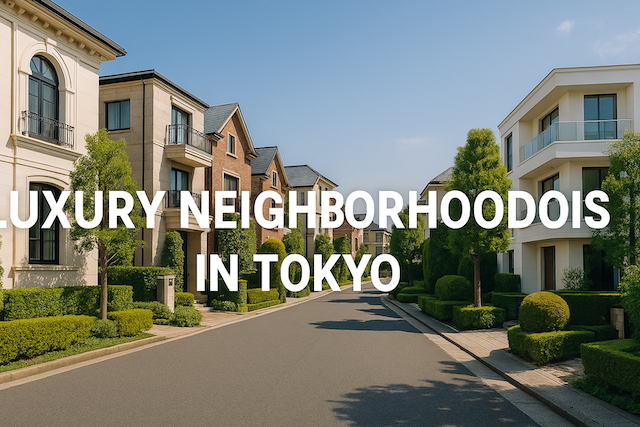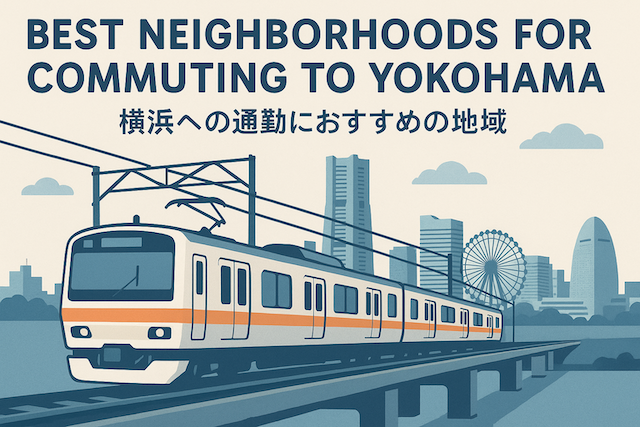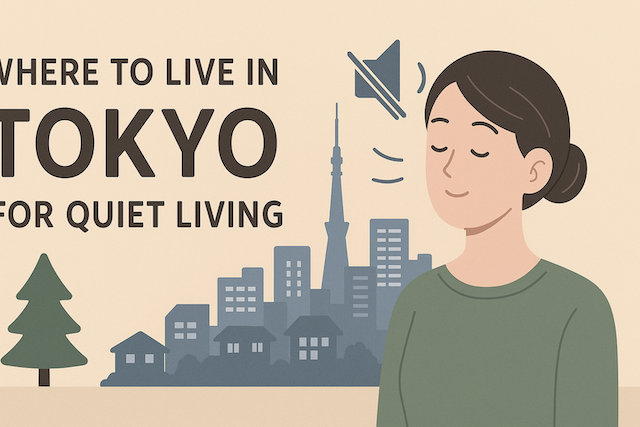Luxury Neighborhoods in Tokyo
Tokyo, one of the world’s most sophisticated capitals, is a city that seamlessly blends tradition, modernity, and luxury. From serene tree-lined avenues to glittering skyscrapers, Tokyo offers a range of high-end neighborhoods that cater to wealthy locals, expatriates, and global elites. Each district has its own distinct charm—some are historic and cultural, while others are sleek and cosmopolitan. In this guide, we’ll explore the most luxurious neighborhoods in Tokyo, their lifestyle offerings, and what makes them stand out as the city’s most desirable places to live.
Minato Ward: Tokyo’s International Luxury Hub
Minato Ward (港区) is often considered the epitome of luxury living in Tokyo. Home to embassies, multinational headquarters, and prestigious residences, it’s where Tokyo’s global community gathers. The area’s cosmopolitan atmosphere and convenient access to both central Tokyo and Haneda Airport make it a top choice for executives and affluent expats.
Roppongi
Roppongi is synonymous with international sophistication. The area’s skyline is defined by the Roppongi Hills and Tokyo Midtown complexes—two luxury developments featuring designer boutiques, Michelin-starred restaurants, and art museums such as the Mori Art Museum and Suntory Museum of Art.
High-rise apartments with panoramic city views, 24-hour concierge services, and private fitness facilities make Roppongi one of Tokyo’s premier addresses.
Azabu-Juban
Azabu-Juban combines luxury with a sense of community. Despite being minutes from Roppongi, it has a calm, residential atmosphere with boutique shops, artisanal bakeries, and fine-dining restaurants. It’s also home to embassies and prestigious international schools, attracting wealthy foreign families.
Luxury low-rise apartments and renovated traditional homes (machiya) are common, providing privacy and understated elegance.
Hiroo
Hiroo is another top-tier neighborhood favored by diplomats and expats. The area offers a perfect balance of sophistication and tranquility. Hiroo’s streets are lined with embassies, gourmet markets, international restaurants, and designer cafes.
Residents enjoy access to Arisugawa Park—a peaceful green oasis in the heart of the city. Many luxury apartments in Hiroo offer spacious layouts and refined interiors ideal for long-term living.
Shibuya Ward: Stylish and Exclusive Living
While Shibuya is known for its youthful energy and bustling streets, it also houses some of Tokyo’s most refined residential enclaves. Areas like Daikanyama, Ebisu, and Shoto represent the pinnacle of stylish, urban living.
Daikanyama
Often compared to Brooklyn or SoHo, Daikanyama is Tokyo’s trendiest luxury neighborhood. It’s famous for its chic boutiques, cozy cafes, and the Daikanyama T-Site complex—an architectural masterpiece that combines bookstores, galleries, and outdoor lounges.
Residents are typically creative professionals, entrepreneurs, and affluent locals who value modern design and relaxed sophistication. Luxury low-rise apartments with modern interiors and rooftop terraces dominate the area.
Ebisu
Ebisu bridges the line between elegance and accessibility. Known for its upscale dining and nightlife, it offers a slightly more vibrant lifestyle compared to Daikanyama. The Yebisu Garden Place development is home to luxury apartments, a five-star hotel, and gourmet restaurants.
Ebisu also provides excellent connectivity via JR and subway lines, making it a favorite for professionals who value both convenience and comfort.
Shoto
Shoto is one of Tokyo’s most exclusive residential areas, located just minutes from Shibuya Station. The neighborhood is peaceful, filled with luxury detached homes and low-rise residences surrounded by greenery.
Many of Tokyo’s celebrities and business leaders choose Shoto for its privacy, security, and elegant atmosphere. The area feels worlds away from the busy streets of Shibuya, yet remains highly accessible.
Chiyoda Ward: The Power Center of Tokyo
Chiyoda Ward (千代田区) is Tokyo’s political and business heart, home to the Imperial Palace and major government offices. It’s also one of the most prestigious places to live, with limited residential areas but exceptional quality.
Hanzomon
Hanzomon, located near the Imperial Palace, offers some of Tokyo’s most scenic and serene luxury residences. Apartments here often overlook the Palace gardens, providing rare green views in the center of the metropolis.
The area is quiet and secure, attracting top executives, politicians, and foreign dignitaries who value discretion and refinement.
Kudan and Ichibancho
These neighborhoods near Kudanshita and Ichigaya Stations are known for their elegant condominiums and embassies. Ichibancho, in particular, is lined with exclusive apartment buildings offering concierge services, private parking, and spectacular city views.
It’s a prestigious location that symbolizes Tokyo’s elite status—perfect for those who value privacy and proximity to the city’s cultural landmarks.
Shinjuku Ward: Classic Prestige in Central Tokyo
Shinjuku is known for its skyscrapers and shopping, but it also hides one of Tokyo’s most prestigious residential areas—Shinjuku Gyoen and Ichigaya.
Ichigaya
Ichigaya is an elegant district along the Chuo Line, popular among professionals and diplomats. The area’s appeal lies in its peaceful atmosphere and proximity to high-end international schools. Luxury condominiums in Ichigaya often feature spacious layouts, modern amenities, and scenic river views.
Shinjuku Gyoen Area
Around Shinjuku Gyoen National Garden, several upscale residences cater to those who value greenery and convenience. Residents can enjoy morning jogs or weekend picnics in one of Tokyo’s most beautiful parks, all while being minutes away from business and shopping centers.
Meguro Ward: Quiet Luxury and Green Living
Meguro Ward (目黒区) is a haven for those who appreciate understated luxury and residential comfort. Its neighborhoods—Meguro, Nakameguro, and Jiyugaoka—offer a more relaxed, artistic, and nature-inspired lifestyle.
Nakameguro
Nakameguro is Tokyo’s most photogenic district, especially during cherry blossom season along the Meguro River. It’s popular among artists, designers, and young entrepreneurs.
Luxury apartments here often combine minimalist architecture with open-concept living spaces and balconies overlooking the river. Despite its laid-back vibe, property prices in Nakameguro are among the highest in Tokyo’s residential market.
Jiyugaoka
Known as Tokyo’s “Little Europe,” Jiyugaoka is filled with stylish boutiques, dessert cafés, and tree-lined streets. It’s ideal for families and professionals who want a blend of suburban calm and urban convenience.
Luxury houses and condominiums here focus on spacious design, natural light, and privacy, making Jiyugaoka one of the most desirable addresses in western Tokyo.
Setagaya Ward: Luxury Family Living
Setagaya Ward (世田谷区) offers a different kind of luxury—space, greenery, and exclusivity. It’s home to Tokyo’s wealthiest families and many celebrities who prefer a quieter, suburban environment without sacrificing access to the city.
Seijo
Seijo, often called “Seijo Gakuen-mae,” is Tokyo’s Beverly Hills. The area features large detached houses, manicured gardens, and private driveways. Many properties here are custom-built, reflecting individual style and prestige.
With excellent schools and family-oriented facilities, Seijo is ideal for long-term residents seeking stability and sophistication.
Denenchofu
Denenchofu is one of Japan’s earliest planned garden suburbs, developed in the early 20th century. It remains a symbol of wealth and class, with Western-style mansions, wide boulevards, and an elegant town layout.
The neighborhood’s architecture, safety, and green spaces make it one of Tokyo’s most exclusive residential zones—often compared to Hampstead in London or Beverly Hills in Los Angeles.
Bunkyo Ward: Cultural Sophistication
Bunkyo Ward (文京区) may not be as flashy as Minato or Shibuya, but it represents quiet, intellectual luxury. The area is known for its universities, traditional architecture, and refined residential communities.
Koishikawa and Hongo
These areas combine history and elegance, with preserved gardens and temples alongside luxury condominiums. Koishikawa Korakuen Garden adds a touch of natural serenity, while modern residences provide all the comforts of city living.
Bunkyo’s appeal lies in its prestige and cultural heritage, making it popular among professors, doctors, and professionals seeking a refined atmosphere.
Conclusion
Tokyo’s luxury neighborhoods each tell a different story—some radiate international flair, while others embody timeless Japanese sophistication.
Whether you prefer the cosmopolitan lifestyle of Minato, the creative charm of Shibuya, or the tranquil prestige of Setagaya, Tokyo offers unparalleled options for those seeking the finest living experience.
Luxury in Tokyo is not only about high-end apartments or designer brands—it’s about lifestyle, privacy, and the harmony between tradition and innovation that defines this world-class city.
FAQs
What defines a “luxury neighborhood” in Tokyo?
In Tokyo, luxury neighborhoods combine prime location, refined urban design, high safety, and access to premium amenities. You’ll typically find low crime, quiet streets, proximity to parks, international schools and embassies, Michelin-level dining, boutique shopping, and buildings with concierge services, fitness rooms, and secure parking. Architectural quality—ranging from high-spec high-rises to elegant low-rise residences and detached homes—also sets these areas apart.
Which wards are most associated with high-end living?
Minato Ward is the international hub (Roppongi, Azabu-Juban, Hiroo) with embassies and corporate headquarters. Shibuya Ward offers fashion-forward residential enclaves (Daikanyama, Ebisu, Shoto). Central prestige is found in Chiyoda (Hanzomon, Ichibancho) near the Imperial Palace. Shinjuku’s Ichigaya and the Shinjuku Gyoen area provide classic central elegance, while Meguro (Nakameguro) and Setagaya (Seijo, Denenchofu) emphasize quiet luxury and space. Bunkyo (Koishikawa, Hongo) delivers cultural sophistication and academic prestige.
How do Roppongi, Azabu-Juban, and Hiroo differ?
Roppongi is cosmopolitan and vertical—think landmark towers, art museums, and panoramic views. Azabu-Juban blends upscale living with a village-like feel, artisan shops, and a tight-knit community. Hiroo is discreet and diplomatic, centered on Arisugawa Park, gourmet markets, and international conveniences. All three are walkable and globally oriented, but the ambience ranges from energetic (Roppongi) to serene (Hiroo).
What makes Daikanyama, Ebisu, and Shoto attractive to affluent residents?
Daikanyama is design-forward, with chic cafés, independent boutiques, and tasteful low-rise residences. Ebisu balances upscale dining and nightlife with excellent transit. Shoto offers privacy, greenery, and exclusive detached homes just minutes from Shibuya—ideal for those seeking quiet without sacrificing access.
Is living near the Imperial Palace (Hanzomon, Ichibancho) truly different?
Yes. Hanzomon and Ichibancho feature rare green vistas, impeccable security, and a dignified atmosphere close to national institutions. Residences often emphasize spacious layouts, concierge-level services, and premium construction standards. The combination of serenity, prestige, and centrality is difficult to replicate elsewhere in Tokyo.
How do Setagaya’s Seijo and Denenchofu compare to central luxury areas?
Seijo and Denenchofu showcase garden-suburb planning, larger plots, and detached houses—Tokyo’s answer to Beverly Hills or Hampstead. While central neighborhoods prioritize vertical luxury and immediate business access, Setagaya’s enclaves emphasize privacy, space, and family-friendly streetscapes, with excellent schools and a slower pace.
What kind of properties are typical in luxury districts?
You’ll see three broad types: (1) High-rise condominiums with hotel-like facilities (concierge, gyms, lounges); (2) Low-rise boutique residences featuring fewer units, high design, and privacy; (3) Detached houses in planned suburbs like Denenchofu or Seijo, often with gardens, garages, and custom interiors. Interior standards commonly include premium kitchens, stone or hardwood finishes, advanced climate control, and strong sound insulation.
Are luxury neighborhoods suitable for families with children?
Absolutely. Areas like Hiroo, Azabu-Juban, and Denenchofu are popular with families for their calm streets, parks, and proximity to reputable local and international schools. Access to pediatric clinics, bilingual services, and family-centric community events is a major draw. Many buildings in these areas also offer child-friendly amenities and layouts with ample storage.
How does transportation access influence “luxury” in Tokyo?
Convenience is a core component of value. Premium neighborhoods typically sit within a short walk of multiple train or subway lines, ensuring rapid access to business districts, airports, and cultural hubs. Even in low-density suburbs, stations are well-connected, and local streets are designed for safe walking and cycling. Private car ownership is more common in suburban luxury areas, supported by secure on-site parking.
What lifestyle amenities should I expect day to day?
Expect curated grocery markets (including imported goods), specialty bakeries, third-wave coffee, fine dining, members’ clubs, spas, art galleries, and boutique fitness. Green spaces—Arisugawa Park in Hiroo, the Meguro River promenade in Nakameguro, Shinjuku Gyoen near central Shinjuku—offer daily recreation. Building-level amenities may include delivery lockers, pet washing stations, private lounges, and rooftop terraces.
How competitive is the rental and purchase market in these areas?
Inventory is limited and demand is steady, so the best units move quickly. International-standard apartments in Minato and Shibuya command premium rents, while family-sized homes in Setagaya are scarce. Buyers should be prepared for thorough due diligence and fast decision-making. Engaging a bilingual agent familiar with embassy standards, renovation history, and building governance (management associations, reserve funds) is advisable.
Are there quieter alternatives that still feel upscale?
Yes. Shoto (near Shibuya) provides exceptional privacy without distance. Koishikawa and Hongo in Bunkyo offer cultured calm with refined residences and historic gardens. Parts of Meguro and Jiyugaoka feel gently upscale, with walkable streets and elegant low-rises—ideal if you prefer subtle luxury over landmarks and nightlife.
What should newcomers prioritize when choosing among top districts?
- Commute & School Access: Map daily routes to offices and schools first.
- Noise & Privacy: Visit at different times of day; check soundproofing and street activity.
- Building Quality: Ask about seismic standards, recent repairs, and management reserves.
- Layout & Light: Corner units, balconies, and south/east exposures often feel most livable.
- Community Fit: Decide between vibrant (Roppongi, Ebisu) and serene (Hiroo, Shoto, Denenchofu).
How can I experience these neighborhoods before committing?
Plan weekend walks: browse Daikanyama’s T-Site and side streets, stroll the Meguro River in Nakameguro, picnic in Arisugawa Park, or tour Yebisu Garden Place. Note grocery options, cafés, clinics, and park access within 10–12 minutes on foot from potential buildings. If possible, schedule multiple viewings in the same block to compare light, noise, and street character.


![Where to Live in Tokyo for Singles [2025–2026 Guide]](https://tokyorelocationguide.com/wp-content/uploads/2025/10/ChatGPT-Image-Oct-17-2025-04_03_58-PM.png)




